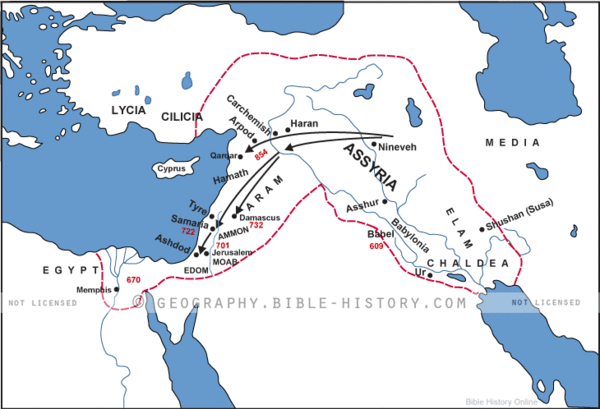Neo-Assyrian Period
The Neo-Assyrian Period goes from 722 BCE to 626 BCE.
< House of David : Ahaz - Hezekiah - Manasseh - Amon - Josiah >
< Kings : {Judges} -- United Monarchy (1047-930 BCE) -- Kingdoms of Judah and Israel (930-722 BCE) -- Neo-Assyrian Period (722-626 BCE) -- Kingdom of Josiah (626-609 BCE) -- Neo-Egyptian Period (609-605 BCE) -- Babylonian Period (605-539 BCE) -- {Second Temple Judaism}>
Overview
The Fall of the Northern Kingdom of Israel-Samaria was the result of the expansion of the neo-Assyrian Empire.
745-727 BCE
Tiglath-Pileser III subdued the Northern Kingdom of Israel. He exacted 1,000 talents of silver as tribute from King Menahem (King of Israel)|Menahem]] of the Kingdom of Israel (2 Kings 15:19) and later defeated his successor Pekah (2 Kings 15:29).
Pekah had allied with Rezin, king of the Arameans against Ahaz (known to the Assyrians as Yahu-khazi), of the Kingdom of Judah, who responded by appealing for the Assyrian monarch's help with the Temple gold and silver. Tiglath-Pileser answered swiftly. He first marched his army down the eastern Mediterranean coast, taking coastal cities all the way to Egypt. This cut off his enemies' access to the sea. Once this was achieved, he returned to the Northern Kingdom of Israel, destroyed their army, and deported the Reubenites, Gadites, and the people of Manasseh to Halah, Habor, Hara, and the Gozan river (1 Chron 5:26). He then installed an Israelite puppet king, Hoshea (732–723 BCE) in the place of Pekah. He concluded this extensive campaign by marching north and west, ravaging Aramaea, seizing Damascus, executing Rezin, and deporting the survivors to Kir (2 Kings 16:9).
727-722 BCE
King Shalmaneser V (727-722) reduced Israel from the status of an ally of Assyria to its colony (727-722).
722/1 BCE
King Sargon II of Assyria (722-705) converted Israel into an Assyrian province after King Hoshea signed a treaty with the Pharaoh of Egypt and defaulted on his tax payments to Assyria in an unsuccessful attempt to regain independence. The Israelite population was exiled and replaced by Assyrian colonists (it is these people who later become known as the Samaritans; see the Annals of Sargon II and 2 Kings 17).
Judea, led by king Ahaz (735-716), was then a small and rather obscure kingdom--a colony of Samaria ("Ahaz walked in the way of the kings of Israel," 2 Kings 16:3). See 2 Kings 16.
715-687 BCE
The new king of Judah, Hezekiah, Ahaz's son, tried to take advantage of the Fall of the northern kingdom to move toward political and religious autonomy (see 2 Kings 18-20). His political and religious reforms found the support of the prophet Isaiah (see Isaiah 36-39), Hezekiah not only eliminated idols, divination practices, and human sacrifice, but he also did away with cult objects long associated wit YHWH (such as the bronze snake which was reputes to have been made by Moses, see 2 Kings 18:4). Hezekiah's anti-Assyrian policy led him to negotiate a treaty with Egypt, in spite of Isaiah's warnings (see Isaiah 30:1-7; 31:1-3).
701 BCE
Sennacherib, king of Assyria (704-681 BCE) sent an army into Judah and laid siege to Jerusalem. The surrounding countryside and nearby cities (such as Lachish were devastated. The Assyrian army, however, withdrew before taking the capital. This was hold as a miracle and a sign of YHWH's protection by the nationalistic party who firmly opposed any compromise (see 2 Kings 18:13-19:37 - Isaiah 36:1-37:38; cf. Isaiah 14:24-27; 17:12-14; 31:4-9). The truth is that the Assyrians had already reached their goal. Hezekiah capitulated, paid the tribute and gave up his dreams of autonomy (see the Annals of Sannecherib and 2 Kings 18:14-16). The Jewish tradition turned a mere escape into a victory, by changing the order of the events (2 Kings 18:14-16, which is lacking from the parallel account in Isaiah 36, is to read at he end of the narrative).
687-642 BCE
Manasseh, Hezekiah's son, king of Judah (2 Kings 21:1-18) was a faithful vassal of the Assyrians. His reign was the longest of any Judahite king. Most of the reforms done by Hezekiah were abolished and the leaders of the nationalistic party were persecuted (according to the tradition, Isaiah also was executed under Manasseh).
642-640 BCE
Amon, Manasseh's son, followed the pro-Assyrian policy of his father (2 Kings 21:19-26).
640-609 BCE
Josiah, Amon's son (2 Kings 22:1--23:30), was 8 years old when he began to reign, following the assassination of his father. At the beginning his policy did not differ from that of his predecessors.
After 626 BCE the decline of the Assyrian Empire, challenged by the rising power of the Babylonians, gave more freedom to the kingdom of Judah.
In 621 BCE Josiah supported the nationalistic party and undertook a series of political and religious reforms, which radically reshaped the religion of the Jews. Inspired by the teachings of the Book of the Covenant (probably an earlier version of Deuteronomy, see esp. chaps 12-26), he purged Jerusalem of the high places, the asherim, and the graves and molten images. Jerusalem became the place of the only temple and the priesthood was made hereditary (the "sons of Levi"). The primary goal of Josiah was to strengthen the unity of the state by centralizing the cult in Jerusalem. Under Josiah, the kingdom of Judah gained a large autonomy and expanded its political power in the region.
609 BCE
In 609 BCE, however, Josiah was defeated and killed in the Battle of Megiddo by the army of Pharaoh Neco, who was going north in the attempt to help the Assyrians agains the Babylonians. Judah fell under Egyptian control (2 Kings 23:26-30).
Jehoahaz, son of Josiah, ruled only 3 months, before being taken captive to Egypt, where he died (2 Kings 23:31-33,34b).
